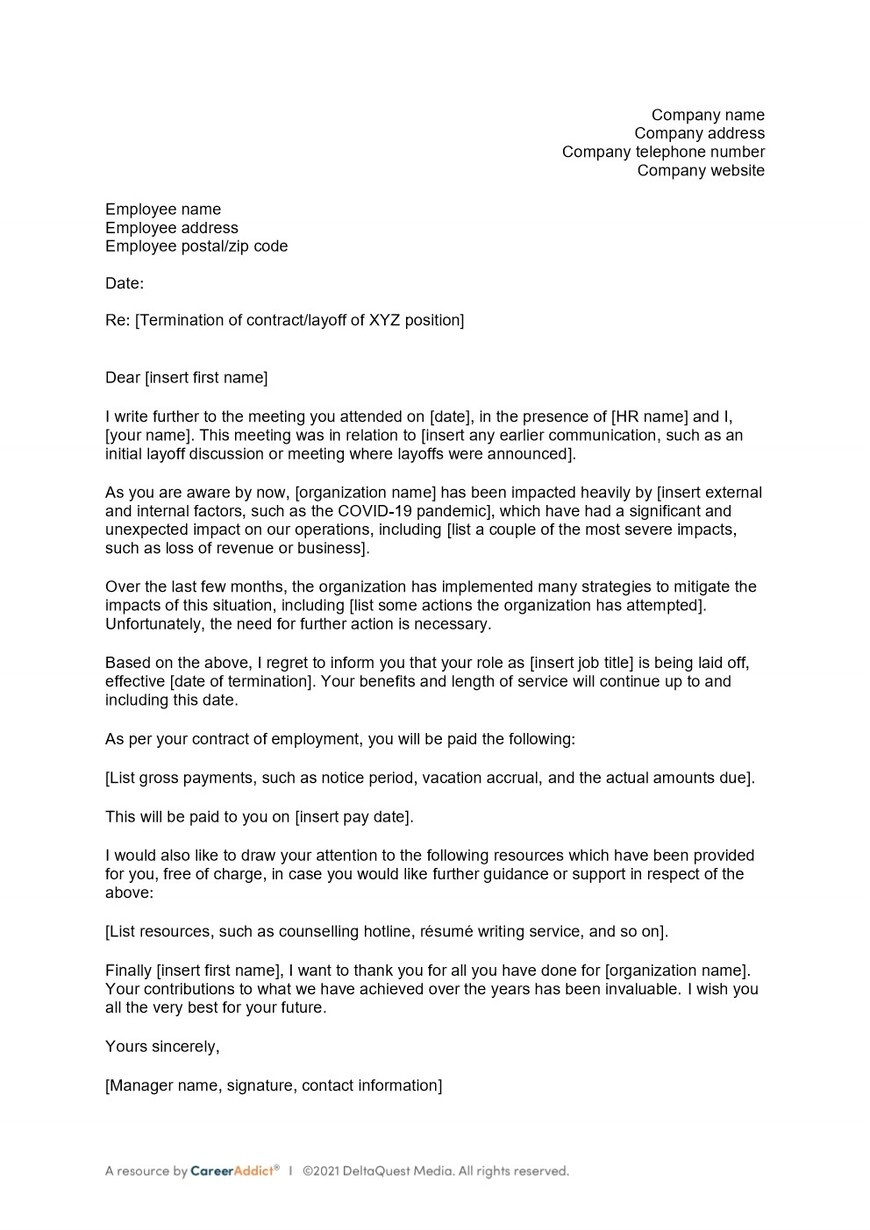Laying off employees — either permanently or temporarily — is never a nice task, but sadly, it’s all-too-common in the world of work. Layoffs are not just caused by lack of business or some other event requiring a sharp reduction in payroll. Sometimes, organizations need to restructure or downsize, meaning that department numbers or headcounts need to be shifted or reduced, and ultimately, this means letting employees go.
Laying off employees needs to be a carefully considered process and culminates in a letter being issued to the affected employees informing them of the decision. As such, this letter needs to be written carefully, as it contains critical information. This article discusses how to write a layoff letter, why it’s important, and a sample letter to consider using.
Why write a layoff letter?
No matter whether your business is small or large, you must send affected employees a letter. The letter is the perfect place to explain the reasons behind the decision, be it a temporary layoff due to COVID-19, or if it’s permanent. Layoff letters are important for a number of reasons, as outlined below.
1. It’s part of employment law
Layoff letters aren’t just ‘nice to write’. In many countries, informing employees in writing of their permanent or temporary laying off is mandatory under employment law and an important part of any inclusive human resources (HR) strategy. In some countries, not confirming a layoff in writing can be a form of unfair dismissal, which can lead to legal action. In the US, you are legally required to provide notice of dismissal in writing under the Worker Adjustment and Retraining Notification (WARN) Act of 1988. When creating a layoff letter, it is important to understand the entire layoff process in your country or territory, and ensure that whatever you do, it’s legal and ethically correct.
2. It clarifies matters for the employee
Being laid off is stressful, and if you ever find yourself in this situation, it is very likely that you will not retain all the information HR, or your manager, is telling you. The second people are told their job is coming to an end, their mind flicks to other things, such as “What am I going to do next?”.
Layoff letters communicate all the important details, such as reasons for the decision, date of termination, payroll and severance information, and what happens next. Having this information in writing allows employees to refer to it in their own time.
3. Everyone affected gets the same news in the same way
Layoffs rarely impact one employee. Often, a whole team or business unit is impacted. Sending out letters to all affected employees guarantees that everyone gets the same information, as it’s there in black and white. This consistency of communication reduces rumor and gossip, as well as the risk of employees complaining that somebody was treated more favorably over someone else.
Steps to writing an effective layoff letter
We’ve put together these steps for you to follow to create an effective layoff letter that will give the affected employees all the information they need.
1. Use a template if you have one
Using a HR template layoff letter will ensure you are exercising consistency in the layoff process. It will also help you reduce mistakes or omissions when informing employees of the layoff. When using a template letter, be sure to check it through, in case you have accidentally left on details pertaining to someone else.
2. Address the employee by name
Addressing the employee by name will ensure an extra check that the layoff letter is going to the people it is intended to. An added benefit of personalizing the letters is that it makes it a little more sincere and meaningful. It will show the employee they are valued as an individual and mean something to the organization.
3. Write it as if a lawyer will be reading it
Try to include as much information as possible in a layoff letter. This will be the date and time of any meetings leading up to the layoff decision, as well as reasoning for the decision. If the employee has expressed concern about the layoff process, try to address these in the letter, outlining your response and justifications. Be as thorough as you can be, but check the HR policies that are in place, in case anything needs to be worded in a certain way or discussed separately.
4. Set the context
Contextualizing the layoff decision will help employees understand that this isn’t their fault. Include factors such as business climate, any other actions you have tried before resorting to layoffs, as well as business reasons for the layoff situation, such as restructuring.
5. Be direct when delivering the decision
Don’t sugar-coat the most critical paragraph of the letter — the fact that the employee will be losing their job. Tell the employee in clear language that their role is being laid off. From here, use clear, concise wording, outlining the particulars of the termination and next steps in clear, factual writing. This will facilitate understanding and avoid any risk of miscommunication.
6. Outline payroll information and severance figures
Ensure that you accurately calculate and inform employees of all money they are due to receive as per their employment contract. Tell them if these payments are gross or net figures, and when it is due to be paid.
7. Offer support to the employee
Many companies have systems or resources in place to support employees through change processes, such as helplines, counseling, or learning and development resources. List these in your letter to employees and consider offering support for a set period after the person has left your employment.
8. Recognize what they have done
Close the letter with a few warm words of recognition in respect of everything the employee has done for your organization. If possible, personalize this with examples, showing compassion, and end with a sincere, warm farewell. It might not seem like the most important thing to include in the letter, but doing this provides a heartfelt sense of closure.
9. Offer a right to appeal (if applicable)
Some territories stipulate that, when an employee is laid off, they have the right to appeal this decision if they think it isn’t fair. If this applies to your country, then ensure the right to appeal is written into the letter, along with the name of the person the employee should appeal to, and their contact information. Failing to do this could constitute unfair dismissal.
10. Leave your name and contact information
Finally, ensure you include your own contact information and full name. The employee might have plenty of questions once they receive the letter, and they need to know how they can reach you. Consider adding in HR contact information as well.
Example layoff letter
Before writing a layoff letter, ensure that you know what needs to be included from an employment law perspective. Also check to see if your organization has any existing templates before you create your own. Nevertheless, a layoff letter will look similar to the following:

Final thoughts
Layoff letters are your best chance — as a manager and an organization — to close off someone’s employment clearly and respectfully. Therefore, even if you are not legally bound to write them, it’s best practice to do so anyway, and it is a good reflection of the way you or your organization treats people.
Layoff letters need to find a balance between being considerate, factual, and caring to the employee. They are designed to be informative and, as much as possible, put the employee’s mind at ease. Where possible, ensure your layoff letters are consistent, and lean on other HR colleagues and experts for advice where needed.
Have you ever had to write layoff letters before? Did you find this useful? If you did, share it with your HR colleagues!

